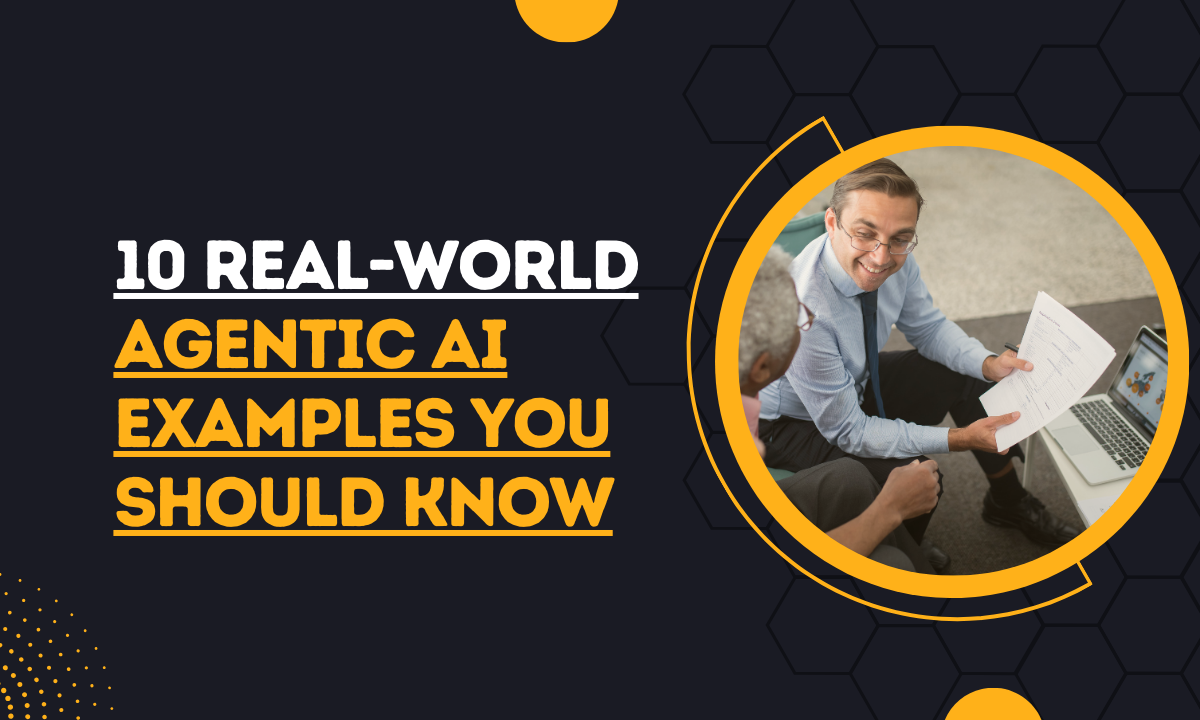10 Real-World Agentic AI Examples You Should Know
Agentic AI with example is meant to show the shifting boundaries of what we thought artificial intelligence could. Essentially moving beyond simple automation into autonomous, goal-driven systems that can plan, decide, and act with little human input.
Imagine tools that anticipate needs, orchestrate workflows, and act in real time while you focus on strategy.
This isn’t science fiction—it’s happening now across healthcare, manufacturing, finance, and broadcasting.
For instance, TV broadcasters are already trialing agentic AI in live production, where systems spot errors, retrieve video, and manage running orders.
In this article, I’ll share 10 real-world agentic AI examples, highlighting their impact, strengths, and how you might apply them.
Customer Service Automation
One of the clearest agentic AI example deployments is in customer service, where systems are expected not just to answer queries but to take action. For instance:
Efficient ticket routing:
The AI determines which issues are urgent and assigns them to the right team.
Multi-language support and resolution: It can respond in different languages seamlessly.
Knowledge base management and feedback analysis: Agents monitor support tickets and user feedback to identify patterns and bring attention to recurring issues.
These systems reduce response times, cut down on human workload, and improve satisfaction.
But they also require careful training on varied data, and continuous oversight to avoid errors or biased behavior.
Product Road mapping and Market Insight
Product teams are using another agentic AI example in road mapping: prioritizing features, monitoring competition, and sensing shifts in customer behavior.
One case involves tools that gather market insights through user behavior, feedback, and competitor moves. They then suggest what features to build next.
Such agents free up leadership from guesswork.
But road mapping agents must balance between signals and noise: not all user feedback is equal, and trends can mislead if you don’t validate them.
Healthcare Monitoring & Patient Care

Source: Artificial Intelligence in Nursing
Healthcare is fertile ground for an agentic AI example.
Some systems monitor patient vitals via wearables or EMRs (electronic medical records).
AI agents detect deviations from norms and escalate alerts only when necessary, reducing false alarms.
Others optimize entire patient journeys: scheduling, follow-ups, even personalized treatment suggestions.
The gains include faster responses in emergencies, better resource allocation, and improved outcomes.
The risk?
Data privacy, safety, regulatory compliance—all must be built in from the start.
Agentic AI Examples and Use Cases
| Heading | Example | Brief Use Case |
|---|---|---|
| Customer Service Automation | Moveworks AI | Routes tickets, manages multilingual queries, analyzes feedback to improve user satisfaction. |
| Product Road mapping & Market Insight | ThoughtSpot | Collects customer behavior, competitor data, suggests features for product development. |
| Healthcare Monitoring & Patient Care | Valtech Healthcare AI | Monitors vitals, escalates alerts, schedules follow-ups, supports treatment personalization. |
| Autonomous Vehicles & Navigation | Waymo | Uses lidar, radar, cameras to navigate, avoid obstacles, adjust routes in real time. |
| Manufacturing & Predictive Maintenance | Pecan AI | Detects anomalies, schedules maintenance, reorders parts, minimizes costly downtime. |
| Finance & Risk Management | Workday AI | Tracks markets, flags fraud, adjusts portfolios, ensures compliance with regulations. |
| Broadcasting & Media Control Rooms | IBC Accelerator Project | Manages running orders, spots errors, retrieves video feeds, responds to director commands. |
| Enterprise Platforms & Workflow Tools | Kubiya AI | Automates workflows, enforces security policies, assists developers with coding tasks. |
| Smart Energy & Grid Management | EnergyCentral AI | Balances energy loads, predicts demand, reallocates supply, avoids blackouts, improves sustainability. |
| Education & Personalized Learning | EdTech Magazine | Creates personalized lessons, tracks progress, provides nudges and extra practice exercises. |
Autonomous Vehicles & Navigation
When you think “agentic,” a famous agentic AI example is self-driving cars.
These systems fuse sensors (lidar, radar, cameras), real-time data, and decision-making agents that adjust braking, steering, navigation without human prompts.

Companies like Waymo are already navigating urban traffic, handling lane changes, obstacle avoidance, rerouting when needed.
But fully safe autonomy still faces corner-cases: bad weather, unusual obstacles, ethical dilemmas etc.
Manufacturing & Predictive Maintenance
Factories are adopting an agentic AI example for predictive maintenance.
Agents monitor equipment performance via sensors, detect anomalies before failures, schedule maintenance during downtime, reorder parts if needed.
This cuts costs, avoids delays, and helps safety.
Another manufacturing example: adjusting production schedules dynamically when supply chain disruptions occur.
The agent doesn’t just alert someone—it acts to replan.
But implementing these agents takes solid data infrastructure and trust in automated decisions.
Finance & Risk Management
In finance, a widely used agentic AI example involves agents that observe market data, detect volatility, adjust investment allocations, or flag risk exposures.
Compliance agents check that actions remain legal and within policy.
For instance, finance firms use agentic AI to automate fraud detection, to adjust portfolios, to manage regulatory risk.
The challenge: markets are unpredictable, models can err, and there’s always risk of over-automation without human guardrails.
Broadcasting & Media Control Rooms
Media has begun deploying another agentic AI example in their live operations.
The UK pilot involving BBC, C4, and ITN is a case in point.
Agents help manage show running orders, spot errors, pull video sources, respond to voice commands from directors in real time.
These systems reduce human load in high-pressure environments and help prevent mistakes on air.
Still, they need to integrate reliably with legacy systems, respect editorial control, and maintain transparency on what the AI is doing.
Enterprise Platforms & Workflow Tools
Enterprise software is embedding an agentic AI example into platforms.
A recent example: ServiceNow’s “Zurich” release introduces agentic AI to enhance security features, development tools, and autonomous workflows.
Agents can enforce code security policies, help developers, and automate parts of software pipelines.
Another example: startups like Sweep that automate go-to-market tasks (CRM updates, alerts, data gathering) by integrating agentic agents with systems like Salesforce and HubSpot.
Agentic AI in Enterprise Platforms
| Use Case | Example | Impact |
|---|---|---|
| Security & Compliance | ServiceNow “Zurich” enforces code security policies | Stronger safeguards and reduced risk |
| Developer Support | Agents assist in coding & pipeline automation | Faster development, fewer errors |
| Workflow Automation | Autonomous workflows streamline tasks | Teams focus on high-value work |
| Go-to-Market | Sweep integrates with Salesforce & HubSpot | CRM updates, alerts, data collection simplified |
| Productivity Scaling | AI augments routine enterprise tasks | Increased team efficiency at scale |
| Governance & Clarity | Define ownership, audits, and error handling | Trust and accountability in adoption |
These empower teams to scale productivity.
But enterprise adoption requires clarity: who owns decisions, how mistakes are handled, how to audit actions.
Smart Energy & Grid Management
Energy providers are testing an agentic AI example in managing smart grids.
These systems can autonomously balance energy loads, predict demand spikes, and reallocate supply between renewables and traditional sources.
Agents make real-time adjustments to avoid blackouts and cut wastage.
This improves sustainability and efficiency.
But challenges include cybersecurity risks, integration with aging infrastructure, and ensuring transparent decision-making in a critical public service.
Education & Personalized Learning
Education platforms are introducing an agentic AI example that adapts lessons in real time.
These systems track student progress, spot weaknesses, suggest new materials, and sometimes intervene with motivational nudges or practice exercises.
This goes beyond adaptive quizzes—it creates dynamic curricula tailored to each student’s journey.
Still, privacy concerns and ensuring teacher oversight remain vital.
FAQ
What defines agentic AI examples vs regular AI or Chatbots?
Agentic AI examples are distinguished by autonomy, planning, decision-making, and action. Regular AI or chatbots often respond to prompts or assist; agentic systems can take initiative, execute multi-step tasks, adapt to context, and operate with minimal supervision.
Are there risks in using agentic AI?
Yes. Common risks include incorrect or biased decisions, lack of transparency, privacy concerns, over-automation (where human oversight is reduced too much), and regulatory or ethical issues.
Some projects may also underdeliver if expectations are too high. Gartner, for instance, forecasts that over 40% of agentic AI projects will be scrapped by 2027, often because business value was unclear or because of inflated claims.
How mature are most agentic AI examples in production?
Many are still in pilot or early rollout stages. Some use-cases (customer service, monitoring, maintenance) are further along; others (fully autonomous vehicles, dynamic enterprise orchestration) are still evolving. The maturity depends heavily on domain, data quality, regulatory constraints, and complexity.
What are best practices for implementing agentic AI?
Start small with a well-defined use-case
Ensure strong data governance and privacy
Maintain human oversight and clear escalation paths
Build in monitoring, logging, and transparency
Engage stakeholders from technical, legal, ethical domains
Will agentic AI replace humans?
Not entirely. In most agentic AI examples, the goal is augmentation: letting agents handle repetitive, time-sensitive, or high-volume tasks so that humans can focus on higher value work—strategy, creative thinking, supervision. Full replacement is rare, especially in domains that demand judgement, empathy, ethics, or creativity.
Related Posts
Are AI Agents Replacing You? Here’s What You Must Know
They’re automating tasks, not your judgment — for now. Focus on skills that combine human insight with AI speed: critical thinking, creativity, and leadership. Learn the tools, own the workflows, and you stay indispensable.
Survive or Vanish: Multimodal AI Applications in Media
Text, audio, image and video now talk to each other — stories are richer and production cycles shrink. Creators who master multimodal prompts and pipelines will dominate attention; those who cling to old silos will fade. Adapt by learning simple multimodal workflows and shipping bold, human-led ideas fast.
Is AI Becoming Your AI Personal Assistant Future or Your Master?
When it’s a tool, it amplifies your choices; when it’s the boss, it narrows them with hidden defaults. Design the relationship: delegate routine, review decisions, and keep ethical guardrails in place. Treat AI like a brilliant apprentice — not the final authority.
AI Threat Lies in Indifference, Not Killer Robots
The real danger is complacency: ignoring bias, privacy, and strategic shifts until it’s too late. Small, preventable failures compound into systemic harm when leaders don’t care until headlines scream. Stay curious, audit systems, and build resilience — that’s how you mitigate the true AI risk.
Conclusion
Agentic AI examples are not just interesting experiments—they are reshaping how modern organizations operate.
From customer service bots that take action, to autonomous vehicles, workflow platforms, energy grids, and personalized education, we already see systems making decisions.
They execute complex tasks, and adapting to changing situations with less human micromanagement.
If you’re thinking of leveraging agentic AI in your team or business, begin by identifying a clear problem that benefits from autonomy, ensure your data and governance are solid, and build iteratively (not all at once).
Those who do will likely gain efficiency, resilience, and innovation advantage—but only if they also plan carefully for the risks.

